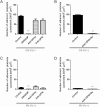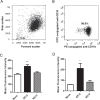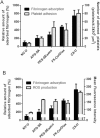Biocompatibility of Polysulfone Hemodialysis Membranes and Its Mechanisms: Involvement of Fibrinogen and Its Integrin Receptors in Activation of Platelets and Neutrophils
- PMID: 30239013
- PMCID: PMC6220809
- DOI: 10.1111/aor.13268
Biocompatibility of Polysulfone Hemodialysis Membranes and Its Mechanisms: Involvement of Fibrinogen and Its Integrin Receptors in Activation of Platelets and Neutrophils
Abstract
Activation of blood cells during hemodialysis is considered to be a significant determinant of biocompatibility of the hemodialysis membrane because it may affect patient health adversely through microvascular inflammation and oxidative stress. This study found very different cell activation among various polysulfone (PSf) hemodialysis membranes. For example, CX-U, a conventional PSf membrane, induced marked adhesion of platelets to its surface and increased surface expression of activated CD11b and production of reactive oxygen species (ROS) by neutrophils; while NV-U, a hydrophilic polymer-immobilized PSf membrane, caused little platelet adhesion and slight CD11b expression and ROS production by neutrophils. Analysis of the molecular mechanisms of the above phenomena on CX-U and NV-U indicated that anti-integrin GPIIb/IIIa antibody blocked platelet adhesion, and that the combination of anti-CD11b (integrin α subunit of Mac-1) and anti-integrin αvβ3 antibodies blocked ROS production by neutrophils. Plasma-derived fibrinogen, a major ligand of GPIIb/IIIa, Mac-1, and αvβ3 on membranes, was thus analyzed and found to be more adsorbed to CX-U than to NV-U. Moreover, comparison between five PSf membranes showed that the number of adherent platelets and neutrophil ROS production increased with increasing fibrinogen adsorption. These results suggested that fibrinogen, adsorbed on membranes, induced GPIIb/IIIa-mediated platelet activation and Mac-1/αvβ3-mediated neutrophil activation, depending on the amount of adsorption. In conclusion, the use of biocompatible membranes like NV-U, which show lower adsorption of fibrinogen, is expected to reduce hemodialysis-induced inflammation and oxidative stress by minimizing cell activation.
Keywords: Biocompatibility; Fibrinogen; Hemodialysis membrane; Neutrophil; Platelet.
© 2018 The Authors. Artificial Organs published by Wiley Periodicals, Inc. on behalf of International Center for Artificial Organ and Transplantation (ICAOT).
Figures








Similar articles
-
A new hydrophilic polysulfone hemodialysis membrane can prevent platelet-neutrophil interactions and successive neutrophil activation.Int J Artif Organs. 2019 Apr;42(4):175-181. doi: 10.1177/0391398818823767. Epub 2019 Jan 14. Int J Artif Organs. 2019. PMID: 30638104 Free PMC article.
-
Platelet-leukocyte aggregates during hemodialysis: effect of membrane type.Artif Organs. 1999 Jan;23(1):29-36. doi: 10.1046/j.1525-1594.1999.06289.x. Artif Organs. 1999. PMID: 9950176
-
Platelet activation through interaction with hemodialysis membranes induces neutrophils to produce reactive oxygen species.J Biomed Mater Res A. 2006 May;77(2):294-303. doi: 10.1002/jbm.a.30608. J Biomed Mater Res A. 2006. PMID: 16400657
-
Interactions between platelets and leukocytes during hemodialysis.Artif Organs. 1999 Jan;23(1):23-8. doi: 10.1046/j.1525-1594.1999.06271.x. Artif Organs. 1999. PMID: 9950175 Review.
-
Hemodialysis effect on platelet count and function and hemodialysis-associated thrombocytopenia.Kidney Int. 2012 Jul;82(2):147-57. doi: 10.1038/ki.2012.130. Epub 2012 May 16. Kidney Int. 2012. PMID: 22592187 Review.
Cited by
-
Validity of Three-Dimensional Tortuous Pore Structure and Fouling of Hemoconcentration Capillary Membrane Using the Tortuous Pore Diffusion Model and Scanning Probe Microscopy.Membranes (Basel). 2020 Oct 29;10(11):315. doi: 10.3390/membranes10110315. Membranes (Basel). 2020. PMID: 33138163 Free PMC article.
-
Artificial Kidney Engineering: The Development of Dialysis Membranes for Blood Purification.Membranes (Basel). 2022 Feb 2;12(2):177. doi: 10.3390/membranes12020177. Membranes (Basel). 2022. PMID: 35207097 Free PMC article. Review.
-
Blood-incompatibility in haemodialysis: alleviating inflammation and effects of coagulation.Clin Kidney J. 2021 Dec 27;14(Suppl 4):i59-i71. doi: 10.1093/ckj/sfab185. eCollection 2021 Dec. Clin Kidney J. 2021. PMID: 34987786 Free PMC article. Review.
-
Hemodialysis Does Not Induce Detectable Activation of the Contact System of Coagulation.Kidney Int Rep. 2020 Mar 13;5(6):831-838. doi: 10.1016/j.ekir.2020.03.010. eCollection 2020 Jun. Kidney Int Rep. 2020. PMID: 32518865 Free PMC article.
-
In Vitro Evaluation of Liposomal Amphotericin B Adsorption With Different Hemofilters for Continuous Hemofiltration.Artif Organs. 2025 Jul;49(7):1126-1131. doi: 10.1111/aor.14980. Epub 2025 Apr 4. Artif Organs. 2025. PMID: 40186392 Free PMC article.
References
-
- Daugirdas JT, Bernardo AA. Hemodialysis effect on platelet count and function and hemodialysis‐associated thrombocytopenia. Kidney Int 2012;82:147–57. - PubMed
-
- Sirolli V, Ballone E, Di Stante S, Amoroso L, Bonomini M. Cell activation and cellular‐cellular interactions during hemodialysis: effect of dialyzer membrane. Int J Artif Organs 2002;25:529–37. - PubMed
-
- Yoon JW, Pahl MV, Vaziri ND. Spontaneous leukocyte activation and oxygen‐free radical generation in end‐stage renal disease. Kidney Int 2007;71:167–72. - PubMed
-
- Pertosa G, Grandaliano G, Gesualdo L, Schena FP. Clinical relevance of cytokine production in hemodialysis. Kidney Int Suppl 2000;58:S104–11. - PubMed
-
- Kakuta T, Komaba H, Takagi N, et al. A prospective multicenter randomized controlled study on interleukin‐6 removal and induction by a new hemodialyzer with improved biocompatibility in HD patients: a pilot study. Ther Apher Dial 2016;20:569–78. - PubMed
MeSH terms
Substances
LinkOut - more resources
Full Text Sources
Other Literature Sources
Molecular Biology Databases
Research Materials

